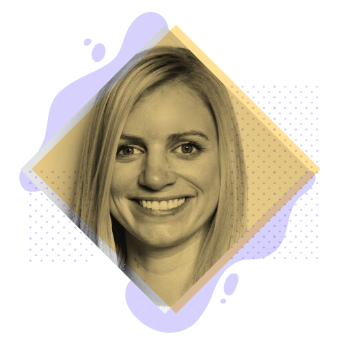Now that we’ve established that the idea of an agile product roadmap isn’t counterintuitive, we wanted to know how real-world agile teams were using product roadmaps.
We picked the brains of five super cool product managers to find out the reality of agile roadmaps. How are real-world, goal-crushing (eternally stressed out) PMs approaching their agile roadmap strategies? Sharing their roadmapping processes, as well as irksome agile roadmap myths and challenges, these PMs clear any confusion around agile product roadmaps. Here’s who we chatted with:
-
Breanna Hughes, Senior Product Manager at League Inc.
-
Catherine Shyu, Product Manager at FullContact Inc.
-
Ahsan Nanji, Director of Product Management at Electronic Arts (EA)
-
Sarah Pyo, Product Manager at Expedia
-
Jessica Johnson, Senior Product Manager at Goodreads
Get our real-world guide to creating any style of agile roadmap. Download it here.
Breanna Hughes

Title: Senior Product Manager
Company: League Inc.
Industry: FinTech
Tweet at her: @unbrelievable
What do you think of when we say agile product roadmap? Go!
I guess it would be like a theme-based roadmap. At a high-level, it’s a problem-based roadmap that outlines the central problem. It’s not a roadmap of features and building. It’s a direction of where you want to go, but being comfortable to iterate as you go.
What’s your approach to your agile roadmap?
Based on business goals and KPIs we define problems we want to solve for the quarter through discovery. From those discoveries comes a list of features to build or tests to try.
Throughout the quarter we evaluate and reconvene. We take a look on a weekly basis with the product team and a monthly basis with the leadership team and ask, “Hey, do we even bother doing this?” That’s where the agile nature comes in.
What’s the biggest misconception around agile and roadmapping that you’ve heard?
That timelines don’t exist. There’s always a timeline. There needs to be! You need some sort of frame of reference to say how much you’re willing to invest in this thing — at least in startups. The reality for most startups is you need to know when this is good enough; when do we move on to a different strategic initiative.
What do PMs need to know before creating an agile roadmap?
KPIs. Definitely need to know why you’re doing it. What is the business impact and your goal for the quarter? You should also know what other teams’ goals are. Make sure you’re not in conflict of one another.
Also, gather tons of feedback. Based on the goals and the areas of the business I want to impact, I’ll talk to stakeholders and customers. Talking to your team is really important too — like your designers and developers. They have great ideas too. Talking to people is the best thing you can do.
What is the biggest challenge when creating an agile roadmap?
The biggest challenge I think is knowing the potential impact of what you release. You can have all the complex formulas and data scientists in the world helping you, but it’s an educated guess at best. Build small first and then build on top of that. It allows you to better predict what the impact is going to be.

Catherine Shyu

Title: Product Manager
Company: FullContact Inc.
Industry: Software
Tweet at her: @cthrin
What do you imagine when we say agile product roadmap?
I think of a loosely planned roadmap for the future of the product. Ideally it has an underlying structure and product principles the company wants to follow, but the exact items (and timing) have the flexibility to change.
Walk us through your own agile roadmap. How do you approach this process?
I’m a visual person, so my roadmap has different swimlanes for each platform. It functions more as a peek into the product vision and where it’s going, so it doesn’t have dates or sizes attached to it.
Once we start planning for the next quarter, the appropriate roadmap items will move into a new document where engineering can size them. We’ll end up with an overarching “Q# List” of items that product and engineering commit to together.
What’s the biggest misconception you’ve heard about agile roadmaps?
The biggest misconception I hear is that the words “agile” and “roadmap” shouldn’t even go together. Working in agile doesn’t mean you no longer have to plan ahead. It just signifies a mindset that lets you change direction faster based on incoming feedback from the customers, the market, and so on.
What does a PM need to know before starting an agile roadmap?
An agile roadmap should be directional, and not so detailed that it goes out of date as soon as you share it with people. Unplanned work will always pop up, and there will be projects that other departments need done too. In practice, adding dates to a roadmap often means you’ll have to update it anytime a date or scope changes. It can quickly become a burden.
What do you find is the biggest challenge when you’re creating an agile roadmap?
Trying to marry a vision for the future with the reality of time—while not having to update it every day. Roadmaps communicate:
- Where a product is going
- Timing of features
- Level of effort required for features
- How features are interconnected and more
We’re likely overloading this one document and trying to fit too much detail in there, which then can become out-of-date. The roadmap tries to do so much, and is consumed by so many different stakeholders that every company’s roadmap is a little different based on their needs.
Ahsan Nanji

Title: Director of Product Management
Company: Electronic Arts (EA)
Industry: Gaming
Tweet at him: @DarthEsso
When we say the term agile product roadmap, what comes to mind?
To me an agile product roadmap is one where the actual timeline and ordering of things aren’t necessarily set in stone, but are oriented around customer responses and requests. An agile product roadmap is kind of done with the intention of change being planned into the process.
Tell us about your own agile roadmap. How does it look?
So what we have is a timeline view of the product that gets broken down into a few different views. One view shows which internal scrum team is working on each feature and which client team adopts which features.
At a high-level, we always have a clear plan two quarters out, with a detailed release schedule over the next 12 weeks. And then we have a vision that goes at least two fiscal years out from today. We’re really just looking at one single, big roadmap with detailed deliverables and feature specs for one to two quarters. Everything that’s beyond is more aspirational.
What’s the biggest myth you’ve heard about agile and roadmapping?
I think a lot of people assume that agile means there’s not much planning involved. I would say there’s more planning and more communication involved.
People think that roadmaps handle communication by themselves, and that’s not the case because you’re assuming everyone is monitoring your roadmap as closely as you might be. So you need to actively communicate any roadmap changes and track who might be affected.
What does a PM need to know before starting an agile roadmap?
There are so many ways to answer that! They should definitely know what the dependencies are for work to be completed. They should have a good sense of the estimates for the work that they’re committing to (for anything being delivered in the short-term). They should also really understand what their customers want or need, and in what order.
What’s your biggest challenge when creating an agile roadmap?
Getting the estimate fidelity and certainty of the schedule, because I know that tends to be the one thing in agile versus waterfall that is a difficult balance to strike. Also, having clear workback plans that give you the confidence that you’re going to actually meet the commitments that you’re making.
No matter your agile style, check out our free agile roadmap template and make it your own.
Sarah Pyo

Title: Product Manager
Company: Expedia
Industry: Travel & Hospitality
Tweet at her: @spyo
When we say agile product roadmap, what do you think of?
I immediately think of timelines and deliveries. Because to me an agile methodology is about getting a team together to continuously deliver in certain timelines. So I really just think of a timeline that can communicate back to my stakeholders within that timeframe.
Tell us about your own agile roadmap. How do you approach it?
My team’s approach is more of a hybrid. In order to communicate to my non-technical stakeholders, I need to break it down into swimlanes that are more simplified — and not so engineering-focused. So we break up our swimlanes by themes that we’re targeting. These are like customer, marketing and product feature goals we have.
We obviously don’t plan for a full year with agile, so when I put together my roadmap I think 120 days ahead. So tackling what we can deliver in four months and breaking that up by themes and overall goals for our customers. That’s how I break it up.
How do you plan for your agile roadmap?
I’m really proud of our process over here. Our teams do the daily stand-ups of course. But we also do grooming sessions with just the product team and our technical product manager. (We’ll also have our UX leads in the room.)
I really rely on those meetings to articulate my thoughts and problems to our leads. Before I can even make an investment, I need to see if it’s something our customers want. We do a lot of discovery before we ship to ensure our use cases are all understood by product.
What is the biggest obstacle when creating an agile roadmap?
I think it comes down to setting expectations for your stakeholders outside of your engineering or UX teams. I know it’ll always be challenging to evangelize what agile is to non-technical teams (there’s a knowledge gap), but it comes down to incorporating those other teams to understand agile processes.
Do you find having an agile roadmap there helps align those psychologies of time better?
Yeah, it does. We do a few steps when we do our roadmap planning. We do high-level numbers and goals for our target months — that 120 days. Which cycle will we hit this? This is what we’re aiming to do. So we set expectations early-on.
Having that visual of the high-level of what we need to do sets that tone for the team so that they know what they want to complete—the goals they want to achieve.
Jessica Johnson

Title: Senior Product Manager
Company: Goodreads
Industry: Social “cataloguing”
Tweet at her: She doesn’t tweet, so connect on LinkedIn!
What do you think of when we say the term agile product roadmap?
Having your cake and eating it too. Everyone wants the speed of agile work but the predictive visibility of a roadmap. While agile on its own is great, I’ve yet to see a larger company be comfortable running totally agile—so you definitely need to find middle ground.
Tell us about your own agile roadmap. How does it look?
I’m a big fan of hybrid approaches. I like roadmaps that use swimlanes to talk more about allocation to a problem than predicted results.
Sure, some major projects with set requirements end up more waterfall, but when you have a problem with no clear end goal, it’s useful to know how much time you can devote. Saying, “Let’s see what we can do in two sprints” is way more accurate than, “It will take us two sprints to get to x outcome.”
Do you think there are best practices in place for creating an agile roadmap?
I think there’s constantly a healthy tension about how much clarity you can create versus how much flexibility you need. On a perfect product team it should adapt. Sometimes becoming more predictable and sometimes giving more slack depending on the scope of the problem.
What’s the biggest myth you’ve heard about agile roadmaps?
That you don’t need a roadmap if you’re agile! The larger your team gets and the more coordination you need across teams, the more important a roadmap becomes. Sure roadmaps are imperfect, but without them coordination is impossible.
How do you plan for your agile roadmap?
There’s a lot of background work in figuring out the priority and dependencies of initiatives. It’s unseen work, but it’s so critical. Digging into data and research; understanding how much time problems might take; coordinating and negotiating with stakeholders. If you don’t do this in advance, you won’t have the right roadmap. After this, it’s just a matter of making the pieces fit with your team’s resources.
What do you find is the biggest challenge when you’re creating a roadmap in agile?
Knowing that even the best laid plans go awry! Despite knowing in advance, it’s hard to be honest and reconcile when you don’t have the time you thought for that pet project.